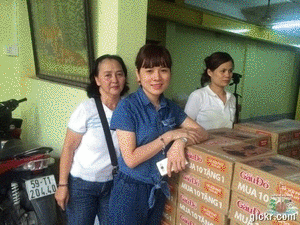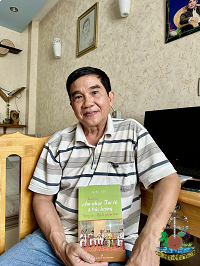•Menu
•Tin đọc nhiều
-
 NSND
Thanh
Nam
và
nghệ
sĩ
Chí
Tâm
ngồi
ghế
nóng
"Chuông
vàng
vọng
cổ"
lần
thứ
19
-
2024
NSND
Thanh
Nam
và
nghệ
sĩ
Chí
Tâm
ngồi
ghế
nóng
"Chuông
vàng
vọng
cổ"
lần
thứ
19
-
2024 -
 Tâm
Sự
Thần
Y
4.0
Tâm
Sự
Thần
Y
4.0 -
 Thông
diệp
của
cải
lương
điện
ảnh
Thông
diệp
của
cải
lương
điện
ảnh -
 Nhiều
người
trẻ
tâm
huyết
với
nghệ
thuật
hát
bội
Nhiều
người
trẻ
tâm
huyết
với
nghệ
thuật
hát
bội -
 “Đêm
huyền
thoại”
quy
tụ
nhiều
ngôi
sao
sân
khấu
cải
lương
“Đêm
huyền
thoại”
quy
tụ
nhiều
ngôi
sao
sân
khấu
cải
lương -
 Thí
sinh
Lê
Hoàng
Nghi
đoạt
giải
Chuông
vàng
vọng
cổ
lần
thứ
19
–
năm
2024
Thí
sinh
Lê
Hoàng
Nghi
đoạt
giải
Chuông
vàng
vọng
cổ
lần
thứ
19
–
năm
2024 - Giữ bản sắc cho cải lương tuồng cổ
-
 CAILUONGVIETNAM.COM
13/04/2004
-
13/04/2025
CAILUONGVIETNAM.COM
13/04/2004
-
13/04/2025
•Tin ngẫu nhiên
-
 Sự
trở
lại
chưa
ấn
tượng
Sự
trở
lại
chưa
ấn
tượng -
 Cây
hài
Kiều
Oanh:
Thèm
một
bi
kịch!
Cây
hài
Kiều
Oanh:
Thèm
một
bi
kịch! -
 Tìm
thấy
1
hài
cốt
người
lính
đã
chết
trận
tại
NHA
TRANG
Tìm
thấy
1
hài
cốt
người
lính
đã
chết
trận
tại
NHA
TRANG -
 MỘT
ĐIỀU
KHÔNG
BÌNH
THUÒNG!
MỘT
ĐIỀU
KHÔNG
BÌNH
THUÒNG! -
 Giọt
Nắng
Phù
Sa
HẤP
DẪN
KHI
NGHỆ
SĨ
VỚI
NGƯỜI
CHƠI
ĐỒNG
ĐIỆU
Giọt
Nắng
Phù
Sa
HẤP
DẪN
KHI
NGHỆ
SĨ
VỚI
NGƯỜI
CHƠI
ĐỒNG
ĐIỆU -
 Sao
lại
đặc
cách
danh
hiệu
NSND?
Sao
lại
đặc
cách
danh
hiệu
NSND? -
 Phong
tục
tập
quán
ngày
Tết
Dương
Lịch
của
các
nước
Phong
tục
tập
quán
ngày
Tết
Dương
Lịch
của
các
nước -
 Khán
giả
“sởn
gai
gà”
khi
đàn
bầu
“đấu”
violin
trong
liveshow
của
nghệ
sĩ
Phạm
Đức
Thành
Khán
giả
“sởn
gai
gà”
khi
đàn
bầu
“đấu”
violin
trong
liveshow
của
nghệ
sĩ
Phạm
Đức
Thành -
 Rạp
Aristo
đã
lui
về
dĩ
vãng
Rạp
Aristo
đã
lui
về
dĩ
vãng -
 Diễn
viên
hài
Hiếu
Hiền,
cứ
nghe
vọng
cổ
là
tôi
nhớ
mẹ
Diễn
viên
hài
Hiếu
Hiền,
cứ
nghe
vọng
cổ
là
tôi
nhớ
mẹ
•Thống kê truy cập
![]() Đang
truy
cập
:
436
Đang
truy
cập
:
436
•Máy chủ tìm kiếm : 60
•Khách viếng thăm : 376
![]() Hôm
nay
:
105016
Hôm
nay
:
105016
![]() Tháng
hiện
tại
:
219752
Tháng
hiện
tại
:
219752
![]() Tổng
lượt
truy
cập
:
100502281
Tổng
lượt
truy
cập
:
100502281
 »
Tin
Tức
»
English
»
Tin
Tức
»
English

CAILUONGVIETNAM.COM 13/04/2004 - 13/04/2025
Sắp tới đây là kỷ niệm 21 năm ngày thành lập trang web cailuongvietnam.com (13/04/2004 - 13/04/2025) Dây là trang tin tức đầu tiên của cailuongvietnam.com từ năm 2004. Còn đuọc gọi là CLVNCOM1 . Thân mời các dộc giả xem những bằi mới hơn tại trang tin tưc CLVNCOM2 theo link dưới dây https://www.cailuongvietnam.com/newscl
Op-Ed: The greatest Mother’s Day gift
Đăng lúc: Thứ bảy - 10/05/2014 10:24 - Đã xem: 4154
Op-Ed: The greatest Mother’s Day gift
As a child growing up, I remember my mother saving the best cuts at dinner for me, making sure my clothes were ironed, that I had books for school and saw a doctor every time I ran a temperature. At that tender age, I already knew that all a mother ever wants is for her children to be healthy, develop well and thrive when they grow up.

Filipino mothers tuck their babies on their chests at a ward of state-owned Fabella maternity hospital in Manila.
Nguồn tin: TNN
Những tin mới hơn
- Actress UT BACH LAN – An Artist’s Life is Like a Short-lived Flower (11/06/2014)
- Vọng Cổ : Sáu Câu (Six Phrases) (18/06/2014)
- Actor Viet Hung (28/06/2014)
- Sixty Zitherists perform in HCMC (03/07/2014)
- Bach Tuyet, A Precious Gem of Cai luong (06/06/2014)
- HISTORY OF VIETNAMESE MUSIC (03/06/2014)
- Ex-ethnic beauty queen says victory made her miserable (25/05/2014)
- Vietnam has full Vietnam has full foundation on sovereignty over Hoang Sa, Truong Sa (27/05/2014)
- Cai luong legend comes to life in photos (29/05/2014)
- Vietnam provinces pledge support foreign investors after riots (18/05/2014)
Những tin cũ hơn
- Traditional Vietnamese music festival kicks off in Bac Lieu (23/04/2014)
- Sad life stories of “Đờn ca tài tử” elite stars (01/04/2014)
- Remembering a hick (hai lua) named Sen (26/03/2014)
- MÁU NHUỘM SÂN CHÙA - YÊN LANG (18/03/2014)
- Ha Long Carnival to take place on April 30 (14/03/2014)
- THE ORIGIN OF THE VONG CO SONG SẦU VƯƠNG Ý NHẠC (07/03/2014)
- Vietnamese artists scoop int’l photo prizes/ City to host first Ao Dai Festival (28/02/2014)
- Don Ca Tai Tu Nam Bo receives UNESCO Award (14/02/2014)
- Opens Restaurant on Dien Bien Phu Street, HCMC (10/02/2014)
- Lunar New Year – a summary of the biggest traditional holiday in Vietnam (01/02/2014)
Mã
an
toàn:
![]()
•CHUYỂN ĐẾN WEBSITE...
•Tin mới nhất
-
 CAILUONGVIETNAM.COM
13/04/2004
-
13/04/2025
CAILUONGVIETNAM.COM
13/04/2004
-
13/04/2025 -
 Thí
sinh
Lê
Hoàng
Nghi
đoạt
giải
Chuông
vàng
vọng
cổ
lần
thứ
19
–
năm
2024
Thí
sinh
Lê
Hoàng
Nghi
đoạt
giải
Chuông
vàng
vọng
cổ
lần
thứ
19
–
năm
2024 - Giữ bản sắc cho cải lương tuồng cổ
-
 “Đêm
huyền
thoại”
quy
tụ
nhiều
ngôi
sao
sân
khấu
cải
lương
“Đêm
huyền
thoại”
quy
tụ
nhiều
ngôi
sao
sân
khấu
cải
lương -
 Tâm
Sự
Thần
Y
4.0
Tâm
Sự
Thần
Y
4.0 -
 Thông
diệp
của
cải
lương
điện
ảnh
Thông
diệp
của
cải
lương
điện
ảnh -
 NSND
Thanh
Nam
và
nghệ
sĩ
Chí
Tâm
ngồi
ghế
nóng
"Chuông
vàng
vọng
cổ"
lần
thứ
19
-
2024
NSND
Thanh
Nam
và
nghệ
sĩ
Chí
Tâm
ngồi
ghế
nóng
"Chuông
vàng
vọng
cổ"
lần
thứ
19
-
2024 -
 Nhiều
người
trẻ
tâm
huyết
với
nghệ
thuật
hát
bội
Nhiều
người
trẻ
tâm
huyết
với
nghệ
thuật
hát
bội -
 Nghệ
sĩ
Bích
Thuận
qua
đời
Nghệ
sĩ
Bích
Thuận
qua
đời -
 Vở
"Sấm
vang
dòng
Như
Nguyệt"
-
dấu
ấn
mới
của
NSƯT
Chí
Linh,
Vân
Hà
Vở
"Sấm
vang
dòng
Như
Nguyệt"
-
dấu
ấn
mới
của
NSƯT
Chí
Linh,
Vân
Hà
•Đăng nhập thành viên
- Những Vở Diễn Hay KIỆT TÁC SÂN KHẤU THẾ GIỚI: LÔI VŨ
- Nghệ Sĩ Tâm Sự Ngọc Huyền 'vẫn bị cấm hát tại Việt Nam'
- Đời Thường Nghệ Sĩ Con dâu trẻ của NSUT Thoại Miêu qua đời chưa đầy 2 năm cưới
- Đời Thường Nghệ Sĩ Nghệ sĩ Tú Sương kết hôn với Việt kiều
- Tâm Tư Thành Viên Người trong giới tự nói gì về nghệ sĩ Mỹ Châu ?
- Trong bầu trời nghệ thuật sân khấu cải lương, nghệ sĩ Thành Được mãi là ngôi sao sáng vĩ đại. Ông đã...
- Tôi cũng biết một soạn giả có tên YÊN BA, nhưng tên thật là PHẠM DIỆP PHƯƠNG, là quân y, KBC 7019
- Bài viết khá đầy đủ về cuộc đời của thầy Văn Hải. Có vài lỗi chính tả không nên có
- thag điên nai ma diên cai gi . toan bac chuoc nsut thanh nam . bat chuoc kieu ngu
- Tôi rất mong chờ để được xem cải lương nhưng thật thất vọng.

CAILUONGVIETNAM.COM 13/04/2004 - 13/04/2025
Sắp tới đây là kỷ niệm 21 năm ngày thành lập trang web cailuongvietnam.com (13/04/2004 - 13/04/2025) Dây là trang tin tức đầu tiên của cailuongvietnam.com từ năm 2004. Còn đuọc gọi là CLVNCOM1 . Thân mời các dộc giả xem những bằi mới hơn tại trang tin tưc CLVNCOM2 theo link dưới dây https://www.cailuongvietnam.com/newscl






































Ý kiến bạn đọc